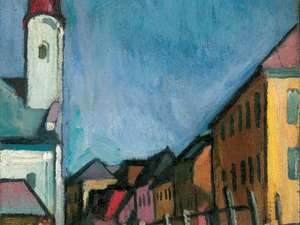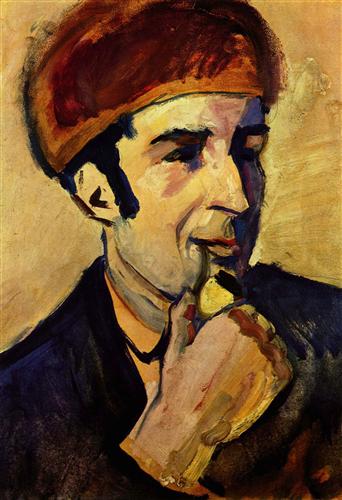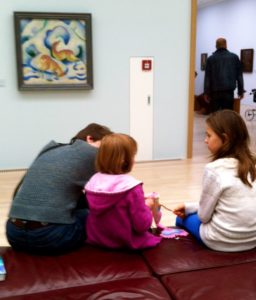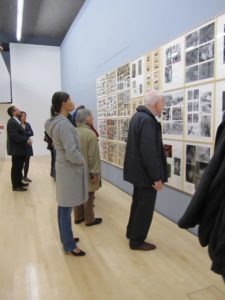
by Jean Marie Carey | 15 Dec 2014 | Franz Marc, German Expressionism / Modernism

Is this colorful village scene painted by August Macke?
I have been working on a project about authenticating a painting maybe misattributed to one of my Expressionist painters (yet maybe made by another), so I was very interested to see a story crop up over the weekend in the Münchner Merkur online edition (pretty sure Süddeutsche Zeitung, usually so on top of all news Bayern, must be spitting nails!) about a man who thinks he owns a painting by August Macke.
Even more intriguingly, the painting would have been made in 1910, the year Macke spent in Tegernsee during which time Franz Marc often came to visit the Macke family, sometimes walking there through Oberbayern from Sindelsdorf to Tegernsee with Russi Marc. This period of time is recounted with warmth and in detail by Margarethe Jochimsen and Peter Dering in the book August Macke in Tegernsee.
The man who owns the painting, Herbert Spiess, claims to have purchased it from an art dealer in Vienna in 1984. Spiess told the Merkur he became convinced the painting, a small streetscape, was a Macke simply through visual association. (The Westfälische Landesmuseum für Kunst und Kulturgeschichte in Münster says “no” in the Merkur’s story; no comment from the Lenbachhaus or the August Macke Haus in Bonn).
Macke enjoyed his time in Tegernsee. This was a happy year for Macke and his wife, Elizabeth and their first son, Walter, was born in the quiet lakeside village. Macke was more or less amused by his botany-obsessed landlords, whose Bayerische dialect he was able to penetrate with Marc’s help. Stubbornly autodidactic and much more fanciful and imaginative than he appeared at a glance, Macke spent hours doing “copying exercises” with Marc (and doing some other fun stuff too), and experimented with many styles of painting and drawing in 1910.
During this time, despite being in a very attractive location, Macke concentrated on portraiture, making many sketches and paintings of Walter, Elizabeth, and the famous portrait of Marc.

Bildnis Franz Marc, August Macke, 1910
But Macke also was always making all sorts of things, from tapestries to fabric designs to theater decorations. So it’s certainly possible this single painting is something he just knocked out during this period of great productivity – Macke was exceedingly prolific and made more than 200 paintings between 1909 and late 1910, when the young family returned to Bonn, leaving cousin Helmuth Macke to stay with Marc.
So it’s hard to say, from looking alone, if this painting could be Macke’s. I hope it is but (and this is really just a very strong intuition as much as empirical assessment) my feeling is that it might not be. To my eye the painting lacks that little flourish of passion and verve, and of capturing the “inner realities” of the beauty he was in the physical world, that is the beautiful Expressionist hallmark of Macke’s oeuvre. With any luck I’m wrong though, and the world will have a new August Macke painting to admire.
Anyway, the reporter, Vera Markert, asks that if you have any information or ideas about the painting to get in touch with the Merkur via email at kultur@miesbacher-merkur.de wenden.

by Jean Marie Carey | 8 Feb 2014 | Animals, Animals in Art, Art History, Franz Marc, German Expressionism / Modernism, LÖL, Re-Enactments© and MashUps

Tierschicksale, 1914, Franz Marc
Was kann man thun zur Seligkeit als alles aufgeben und fliehen? als einen Strich ziehen zwischen dem Gestern und dem Heute? – Franz Marc, February 1914, from the intended introduction to the second edition of the Blaue Reiter Almanac. First printed in Der Blaue Reiter. Dokumentarische Neuausgabe by Klaus Lankheit. München, 1965, p. 325.
One of the most frequently cited articles about Franz Marc in popular literature is Frederick S. Levine’s “The Iconography of Franz Marc’s Fate of the Animals” from a 1976 issue of The Art Bulletin, and, subsequently, a short book on the same subject. Apparently there are some issues with the accuracy of the translations presented in both. What’s interesting to me is the creative idea Levine had to analyze Marc’s enormous 1913 painting Tierschicksale (mysteriously residing in the Kunstmuseum Basel) as an expression of Ragnarök, the apocalypse of Norse mythology. My opinion is that despite being generally familiar with the Eddas and with Der Ring des Nibelungen Marc wasn’t that interested in these sagas and didn’t consider them as particularly German.
A few years ago Andreas Hüneke, researching at the Lenbachhaus, discovered that the inscription on the back of the painting, „Und alles Sein ist flammend Leid“ is from a volume of the Buddhist Dhammapada of the Pali Canon of Buddha Siddhartha Gautama given to Marc by Annette von Eckardt. So it doesn’t seem to refer to Ragnarök directly as Levine (not having the benefit of Hüneke’s recent work) asserts. It seems more likely that Marc was very distressed, in the summer of 1913 when he made Tierschicksale, about von Eckardt’s move away from Munich to Sarajevo. It explains a little bit about why, upon seeing the painting again a few years later, Marc says he doesn’t even remember creating it and ascribes its meaning to the more external conflagration at hand.
In any case, Levine was not discouraged by his translating experience and went on to the faculty at Palomar College in California and also spent a lot of time studying and teaching at the University of Tasmania in Hobart.
Today, on Marc’s birthday, with so many animals imperiled, Tierschicksale doesn’t really need any overdetermining; it would be very tempting to just turn and flee, if only there was somewhere to go.

by Jean Marie Carey | 6 Jan 2014 | Animals, Animals in Art, Art History, Franz Marc, Music

Franz Marc’s Deer in the Snow at the Lenbachhaus; Persona
The article M83: Why Music Is Contemporary Art on the Installation website provides an excellent forum, in the comments section, for the discussion of the title subject.
I like M83 a lot and agree that their sound is ambitious beyond poptronica though as commenters on the Installation site point out this is not necessarily because of compositional enterprise or chord progression For me the attraction is the “celebrate the apocalypse” mood of “Midnight City” or the spoken “created sample” in “OK Pal:”
“We’re walking in the streets – or what’s left of them,
I take your hand, and the city is slowly vanishing.
There’s no crowd anymore, no cars, no signals.
But in the middle of the road, a purple and mellow shape is floating.
The shape of our mutual dream.
Stay calm, hold me tight, give it a chance to take us away.
We will live, we will dream on the shadow of our world.”
I had a dream the other night that incorporated both this song and the painting in the photo, Franz Marc’s Deer in the Snow (1911). In the dream a good friend of mine who recently has been through a difficult time was one of the deer, but hampered by a hank of rope or net caught between her hoof and head. The reindeer tender freed her, and despite being “caught,” my friend as the deer, didn’t have any broken bones, or even any bruises or lost fur. I hope she will be OK like the deer in the dream. In the dream, I heard the music from “Midnight City” (which reminds me of this friend). I don’t know why anyone would think people (and animals) don’t see colors or hear music in dreams…maybe everyone does and they just forget.

by Jean Marie Carey | 10 Nov 2013 | Art History, Franz Marc, German Expressionism / Modernism

Atlas Mikromega @ the Lenbachhaus
A few years ago I went through a phase of being consumed with interest in Gerhard Richter’s cycle of 15 paintings, Baader-Meinhof (18. Oktober 1977). Writing this now my obsession seems doubly strange because I did not then have the geographic or cultural context for these works I have in 2013. One spring break I had seen the paintings – based upon photographs of Ulrike Meinhof, Holger Meins, Gudrun Ensslin, Andreas Baader; the funeral of Jan-Carl Raspe, and Baader’s books and record player – at the Museum of Modern Art and had a very strong reaction to them. I think I explored this subject so intently because my response was the opposite from my feelings for Franz Marc’s animals. The blurred details of the black and white photographs of portraits, news stills, and police snapshots made the subjects abjectly lifeless. The effect was like the dream of freezing; cold, sad, and bitterly empty. The paintings made me drained and ill. Yet I was fascinated by the tension – and desire – that was generated by being repelled by images whose subjects I was very drawn to.
(more…)

by Jean Marie Carey | 9 Jun 2013 | Art History, German Expressionism / Modernism

There were opportunities during Isabelle Graw’s presentation this past week at the Lenbachhaus to make some some site-specific comments about the collections at hand, and Graw did make tangential connections to work by Joseph Beuys and Wolfgang Tillmans, thought not those which belongs to the museum’s Kunst Nach 1945 collection.
Intensely and yet breezily theoretical (I have heard Graw speak several times, on one of those occasions dismissing the Adorno-Horkheimer ‘culture industry’ works most art historians spend their lives trying to understand as insufficiently complex for her needs in explaining the reification of art) Graw is an engaging speaker, readily admitting that many of her contentions create oppositional paradoxes which thus cannot be argued against. Graw herself occupies dual roles, as professor for Art Theory and Art History at Staatliche Hochschule für Bildende Künste in Frankfurt am Main and as an art critic and co-founder of Texte zur Kunst, the respectable but for-profit Berlin art journal. Graw also has a heavy amount of street cred coming from a lengthy association with Martin Kippenberger during Kippenberger’s time in Cologne.
 Her talk at the Lenbachhaus, Malerei als indexikalisches Medium in der neuen Ökonomie recasts the idea that paintings are “alive” somehow in the sense that they emanate an autonomous value in terms of the role of Painting with a “P” as both commodity and part of the larger “organism” of the process and documentation of the making of art.
Her talk at the Lenbachhaus, Malerei als indexikalisches Medium in der neuen Ökonomie recasts the idea that paintings are “alive” somehow in the sense that they emanate an autonomous value in terms of the role of Painting with a “P” as both commodity and part of the larger “organism” of the process and documentation of the making of art.
Indexical is a word mostly associated in art history with photography, and photography is important to Graw’s current interest, which expands upon many of the ideas she raised in her recent book High Price: Art Between the Market and Celebrity Culture in the sense that “documentary indexicality” is all but a de-facto given the ubiquity of record-making technology. Additionally, in the trinity of “icon/index/symbol,” “index” marks a definite place and time by compelling a reaction in the beholder. But I think it is the more abstruse “referential indexicality” that most interests Graw in this sense, as she used Diedrich Diedrichsen’s term “Selbstdarsteller” to describe Kippenberger’s performances of himself as himself (as opposed to performing “the other” or just “being” himself).
(more…)







